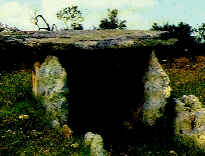Megaliths in Western Europe
![]()
" They lived like gods, their heart free of any concern
When they died it had been said that they fell asleep. " Hésiode
Thus, in 8th century before our era, the Greek poet idealized ancient times known by legends. But, was this really " the GOLDEN AGE "? Who were the men who worked out communities able to bequeath this gigantic stone heritage to us?
Men of the Megaliths
![]()
** Their ancestors were farmers of the Neolithic era, who , 8000 years ago, came from the Middle East.
Two routes are to be noticed:
- One by the sea then rivers: The Mediterranean, Valley of the Rhone.
- The other through the Aegean Sea to Greece and Balkans, then the Valley of the Danube.
1500 years later, the descendants of these pioneers had acquired a sedentary way of life which enabled them to build these gigantic stone monuments . 6000 years ago, some crossed the Channel and settled in the British Isles . Displacements of the settlers were carried out at the rate of 30 kilometers per generation, according to the exhaustion of the cultivable soils .
** During their peregrinations in a temperate Europe, covered with dense forests only cut out by rivers - access paths crossed by wood pirogs or leather canoes -
 |
 |
 |
the settlers , clearers and builders, encountered the autochthons , hunter-gatherers , who occupied the continent since millenia .
It seems that the local populations and the new ones mixed well together because, on many sites, were found Mesolithic stone tools and Neolithic artifacts. Moreover, the farmers did not protect their villages with palisades or ramparts, which let us think that few serious conflicts occurded between them.
** From this mixing of cultures rose an original civilization, living in small dispersed communities and thus, maybe more inclined to undertake vast Community works .
** It is more than probable that once the new colony was well established ,dwellings and harvests ensured, the men of the European Neolithic era had sufficient leisure to be occupied with a social life which cemented the relations within the group. These activities concentrated especially around the construction of a monument which would be , at the same time , place of ceremony and burial.
 |
 |
 |
 |
 |
 |
| 4 standing stones covered with a tabular flagstone as roof : a Dolmen . Dolmen in The Abruzzi, in Italy |
Lengthened version of the dolmen,a dolmen with corridor, where burials were made along the walls. The dolmen with corridor of Mougau in Commana , Brittany |
Chambered-tomb : The Great Cairn of Barnenez includes 11 chambered-tombs . Brittany |

